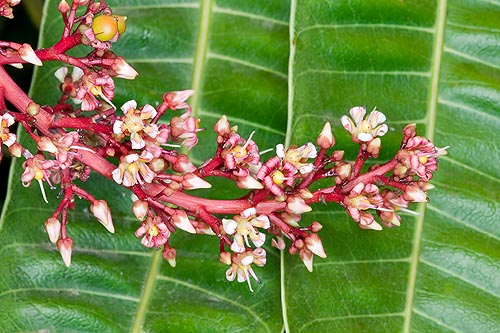Family : Anacardiaceae

Text © Pietro Puccio

English translation by Mario Beltramini

Turpentine tasty fruits, better humidity resistant than common mango © Mazza
The name of the genus comes from the combination of one local name of its fruits, “manga”, with the Latin verb “fero” = I carry; the Latin name of the species, “odorata” = fragrant, refers to the intense odour emitted by the flowers.
Common names: “bembem”, “kuweni”, “kaweni” (Indo- nesian); “wani”, “huani” (Malay); “fragrant mango”, “kuweni mango”, “kuini”, “kuwini”, “saipan mango” (English); “mangue odorante”, “manguier à fruit odorant”, “manguier odorant” (French); “juani”, “kuwini” (Spanish).
Evergreen tree, tall up to 15-20 m, or little more, with a greyish bark which exudates an irritating resin with a strong smell, the crown is globose, or somewhat columnar, with oblong-lanceolate leaves, 15-35 cm long and up to about 10 cm broad, coriaceous.
The inflorescences are terminal, panicle, long up to 50 cm, thick, with flowers of about 6 mm of diameter, with yellowish petals with a shade of pink, intensely fragrant.
The fruits are oblong, flat drupes, long 10-12 cm, of a greenish colour, the pulp is yellowish, fibrous, with a strong smell and taste of turpentine. It reproduces by seed, the selected varieties by grafting.
The plant is cultivated in very humid climate areas of the Philippines, Indonesia, Malaysia, Thailand and Vietnam, where the common mango (Mangifera indica) is not suitable, particularly in the less fibrous pulp varieties and with less strong taste and scent of turpentine; the fruits are to be eaten when well ripe and peeled, the contact with the unripe pulp can provoke serious allergy reactions. The wood, of poor quality, is scarcely utilized.
→ To appreciate the biodiversity within the ANACARDIACEAE family please click here.
